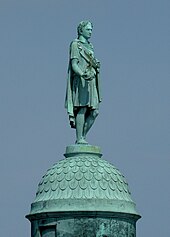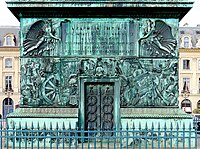Colonne Vendôme
The middle of the Place Vendome in Paris standing Colonne Vendôme is a victory column , which was built from 1806 to 1810.
history

The Place Vendôme was laid out by Jules Hardouin-Mansart under Louis XIV and received an equestrian statue of Louis XIV in the middle , which was destroyed during the French Revolution .
Predecessor statue
After the Place Vendôme had been exposed by decree of September 12, 1685 by the building contractor Jean Masneuf , a 7 m high equestrian monument with King Louis XIV was erected on a 10 m high base in the center of the square on August 13, 1699, designed by François Girardon but it was destroyed on August 7, 1792 during the French Revolution . Between 1699 and October 1, 1701, Masneuf also carried out Mansart's planned perimeter development of the square, for which initially only facade scenes were intended.
Since 1799 the square has had its current name, Place Vendôme . On October 1, 1803, Napoleon Bonaparte signed a decree to erect a new column in the square. This time the model was the Trajan Column in Rome. The foundation stone of the 44.3 m high column with Napoleon as emperor was laid on August 25, 1806. The triumphal column was cast from 133 (and not as often read 1,200) Russian and Austrian cannons, which resulted from Napoleon's victory in the Battle of Austerlitz in 1805 against the armies of Austria and the Russian Empire. The column has a diameter of 3.65 m and cost 1.5 million livres to build. It was inaugurated as the “Colonne de la Grande Armée” on August 15, 1810. In 1814 the statue of Napoleon on the top of the column was dismantled and melted down in order to erect an equestrian statue of Henry IV on the Pont Neuf . On March 1, 1833, the column with a new statue of Napoleon I was inaugurated on Place Vendôme .
The column was dismantled on May 16, 1871 during the Paris Commune , for which the painter Gustave Courbet , who, as a member of the Commune , had spoken out in favor of moving the column in front of the Hôtel des Invalides , was held responsible. The politically active painter Courbet, who was already known in his day and lived in the immediate vicinity of the column, repeatedly called for the removal of the Colonne Vendôme for political and aesthetic reasons. During the Paris Commune, the Communards complied with Courbet's request for political reasons and entrusted Courbet with leading the work on the demolition of the column. A wooden frame was attached to the column, the column was sawn into several segments and the space in front of the column on which the remains were to fall was covered with straw or dung. On May 16, 1871, the Colonne Vendôme was knocked down with the help of ropes and a winch in front of many onlookers, after the rope had previously broken twice. The bronze plates of the column were saved. After the end of the commune, the president of the newly created republic, Patrice de Mac-Mahon , decided in 1873 to have the Colonne Vendôme rebuilt at Gustave Courbet's expense. At the time of his death in 1877, the painter had not yet paid off the enormous sum.
Statues of Napoleon
The first statue of Napoleon was created by the sculptor Antoine-Denis Chaudet (1763-1810). It was removed in 1814 and melted down in 1818. During the July monarchy in 1833, Charles Émile Seurre was commissioned to create a new statue depicting Napoléon as a "petit caporal". This statue is now in the Cour d'honneur des Hôtel des Invalides . Napoleon III had this second statue replaced by a copy of the first. This replica was created by Augustin-Alexandre Dumont .
description
The column is 44.3 meters high and 3.60 meters in diameter. It stands on a pedestal and is crowned by a statue of Napoleon. The Trajan Column in Rome served as a model .
The column shaft consists of 98 stone drums, which are clad with a bronze relief . The relief depicts battle scenes and trophies . This band, which winds around the column, consists of 425 bronze plates and is 280 meters long. It was drawn by Pierre Bergeret and executed by several artists: Jean Joseph Foucou , Louis Boizot , François Joseph Bosio , Lorenzo Bartolini , Claude Ramey , François Rude , Edme Gaulle , Clodion , Ruxthiel and others. a. Inside the column, a staircase leads to the platform on which the statue of Napoleon as " Caesar imperator " stands.
The column base is made of porphyry mined in Algajola in Corsica . The Latin inscription reads:
| NEAPOLIO IMP AVG MONVMENTVM BELLI GERMANICI ANNO MDCCCV TRIMESTRI SPATIO DVCTV SVO PROFLIGATI EX AERE CAPTO GLORIAE EXERCITVS MAXIMI DICAVIT |
In German, for example:
Napoleon Imperator Augustus (exalted emperor)
dedicated this monument to the war in Germany in 1805 ,
completed in three months under his leadership,
made of bronze captured from the enemy, to
the glory of the Grande Armée (Great Army).
location
The nearest stations of the Métro are Madeleine (lines 8, 12 and 14), Opéra (lines 3, 7 and 8) and Tuileries (line 1). Since March 31, 1992, the column is one of the monuments ( historical monuments ). It is on Place Vendôme , which is between the Paris Opera and Rue de Rivoli or Rue Saint-Honoré .
literature
- Jean Colson, Marie-Christine Lauroa (eds.): Dictionnaire des Monuments de Paris , Paris 2003 (1st edition 1992), pp. 816–818, ISBN 2-84334-001-2
- Georges Poisson : L'Empereur, Colonne Vendôme. In: Geneviève Bresc-Bautier, Xavier Dectot (Ed.): Art ou politique? Arcs, statues et columns de Paris. Action artistique de la Ville de Paris, Paris 1999, ISBN 2-913246-02-8 , p. 94f. [not evaluated]
- Edgar Schmitz: The Trojan Horse and the Restoration. The dispute over the Colonne de la Place Vendôme as a paradigm of the failed restoration. In: Gudrun Gersmann , Hubertus coal (ed.): France 1815–1830. Trauma or utopia? The Society of Restoration and the Legacy of the Revolution. Steiner, Stuttgart 1993, ISBN 3-515-05831-1 , pp. 187-196 (preview on Google Books). [not evaluated]
- Paul d'Abrest : Courbet and the Vendôme column . In: The Gazebo . Issue 9, 1878, pp. 148–150 ( full text [ Wikisource ]).
Web links
- Colonne Vendôme in the Base Mérimée of the French Ministry of Culture (French)
Individual evidence
- ↑ Jacques-Antoine Dulaure, Jules Léonard Belin: physique Histoire, civile et morale de Paris . Volume 3, 1839, p. 207; Text archive - Internet Archive
- ↑ Paris Sights , 2010, no p.
- ↑ a b c d Paul d'Abrest : Courbet and the Vendôme column . In: The Gazebo . Issue 9, 1878, pp. 148–150, here p. 148 ( full text [ Wikisource ]).
- ↑ In the source Courbet and the Vendôme column (gazebo) is spoken of May 15, 1871.
- ↑ Reinhard Alings: Monument and Nation . The image of the nation state in the medium of monument - the relationship between nation and state in the German Empire 1871-1918. de Gruyter, Berlin 1996, p. 65 .
Coordinates: 48 ° 52 ′ 2.9 ″ N , 2 ° 19 ′ 45.9 ″ E





